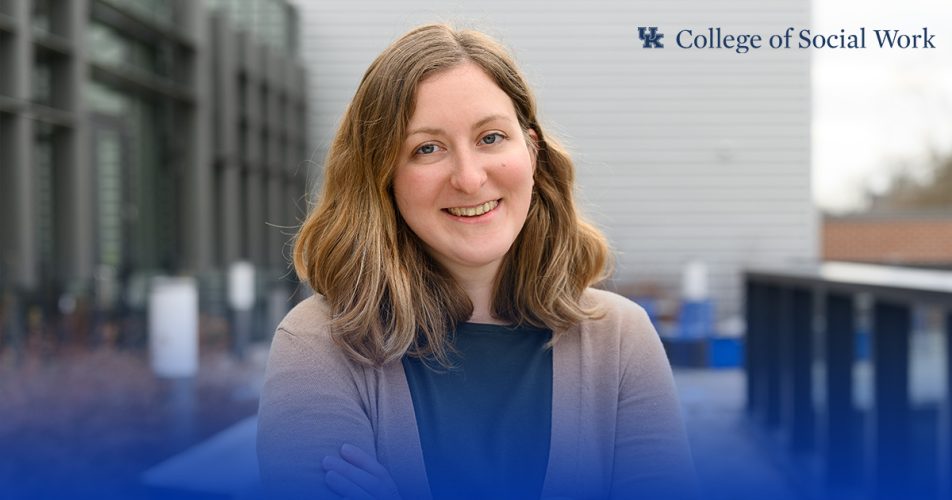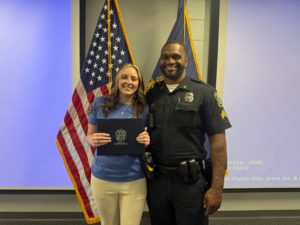About 20 people per minute are physically abused by an intimate partner in the United States, more than 10 million people annually, according to the National Coalition Against Domestic Violence.
Dr. Kathryn Showalter, PhD, is an Assistant Professor at the University College of Social Work whose research is focused on domestic violence, related workplace issues, and public policy to address intimate partner violence.
The conversation that follows has been lightly edited for length and clarity.
Dr. Showalter, what brought you to UK College of Social Work, and why did you decide to research intimate partner violence (IPV)?
As far as joining the field, that happened early. I took a social work class in college, and I thought it was so awesome that social workers get to help people in a very practical way. I came to realize that intimate partner violence was something I was passionate about during my practicum course, which was an internship at the Women’s Employment Network in Kansas City. It is a wonderful organization that helps women find jobs. There, I realized I had a lot of clients that were experiencing intimate partner violence, and I could see the way that it had this ripple effect on their lives. I really wanted to know more about that and the way that abuse had not only been traumatic but had this lasting effect on their career and their well-being.
I knew when I started at the UK College of Social Work that I wanted to understand the types of jobs that women who experience intimate partner violence have, and the ways that we can potentially help in those different positions. Jobs or employment is a very big field of research. I wanted to look at work strategically and see if there were differences by sector and role. Domestic violence is mainly perpetrated against women, and so I thought it was logical to start with a female-dominated sector, specifically nursing. I think a lot of people have used the term domestic violence to refer to same-sex couples and couples who are married. Intimate partner violence is a little bit more inclusive because it covers different types of relationships. It includes anything from physical to economic to psychological abuse.
What is economic sabotage in a relationship, and what might that look like in the workplace?
Strategic work sabotage can look like calling your phone all day long to try to distract you while you’re working. It can look like hiding your car keys so you can’t drive to work, or you are late. It could be disconnecting the Internet or starting a fight before somebody goes to work so they feel upset and it’s hard to concentrate.
There were not previously measurements for those kinds of experiences, so that is a big area of focus for my current work, which is supported by the UK Center for Research on Violence Against Women. And it was important to include technology because it is unfortunately a big tool now that abusive partners can use against someone, and much of that impact has not been studied.
We live in a digital age, where most people have internet-connected cellphones with cameras, and many participate in online platforms. What are some things people should be aware of when using social media and other online tools, especially regarding IPV?
I think it’s virtually impossible to just turn it off. Your data and your online presence and everything that is inside of our smartphones can’t be easily erased. Everyone has an online digital footprint now. Abusive partners can use that in a million different ways, even if I were to throw my phone in the trash. My abusive partner can still destroy me. They can harass my friends and my coworkers through digital platforms. They can post things about me or photos that I don’t want other people to see to hurt me.
And this can happen even if I don’t have contact with them through my phone–everything from GPS tracking to software hacking. Someone can take control of your computer or look at all of your emails or your calendar. They can find out where somebody is located or planning to be. I think that it’s very scary and makes people more vulnerable to cyberstalking.
To protect yourself, I think documentation is the best thing anyone can do. You have to build the evidence. Here are some ways to do that: https://www.techsafety.org/documentationtips
What are some of the biggest misconceptions about domestic violence?
In my research, I’ve asked participants what are things you wish people understood about your situation? Two things that they say the most are, first, that I can’t just leave. I can’t. I can’t just pack a suitcase and leave. It’s not that simple. And I think the reasons behind that can be different. But of course, people’s lives are complex. And it’s important to trust survivors in that judgment call of is this the right time to leave or is it not? The second one that survivors tell me is that abuse is not just physical–there is an impact on self-esteem and mental health. There are many ways that abusive partners have strategically undermined their victims to try to just destroy and control them.
As a researcher, I would add that this is truly also an issue of race–particularly in the workplace or maybe even social settings in general. People are less helpful to women of color who are experiencing domestic violence. They are less likely to give them the same opportunities, the same level of understanding, the same patience that they would a white woman and I think that that goes back to stereotypes. Unfortunately, there is a lot less understanding for women of color who experience domestic violence.
How does your work help inform better policies and approaches for organizations and businesses?
I don’t think that this research is meaningful if it doesn’t have an impact on policy. I think you must use the information you have to try to better people’s lives. There is a lot of growth that we need to do–states have taken dramatically different approaches to addressing domestic violence, and we really have no idea what the effect of those policies have been on the state level because many have not been studied and many are not based in evidence. For example, there are 28 states that allow people to take time off of work without getting fired if you are experiencing domestic violence. But it is very haphazard–some states offer an unlimited number of days to take off for addressing the situation. Other states give you three days. Three days available to uproot your entire life and maybe change jobs and or change your home—it is very difficult to do this.
Businesses lose millions of dollars every year because of domestic violence, but it’s not something that many business leaders necessarily think they should be involved in or create a plan to handle. In some workplace cultures, there’s an attitude of whatever happens to you at home happens to you at home, it’s not our place to do anything. But it does have an impact on workers and the way they come to work (or can’t) and are able to be productive. Unfortunately, we usually see employers come up with a policy to support domestic violence victims and help them access resources after something terrible has happened at that workplace. It’s a reactive policy instead of a proactive policy.
I want to communicate that there is hope. For people who want to help victims find stability for themselves and their families, it can be as simple as asking if they are OK and keeping what they tell you confidential.
Dr. Kathryn Showalter, PhD, is an Assistant Professor at the University College of Social Work, whose research focuses on domestic violence intimate partner violence and the employment stability of survivors of abuse, abusive workplace disruptions and strategic economic sabotage by romantic partners, and family financial well-being and employer support of intimate partner violence survivors. Her work has been published in the Journal of Family Violence and Journal of Interpersonal Violence. She is currently working on several research projects related to public policy for intimate partner violence and workplace issues. Dr. Showalter received a Bachelor and Master of Social Welfare from the University of Kansas and a PhD in Social Work from The Ohio State University. To learn more about her work, please visit her University of Kentucky Scholar page.






